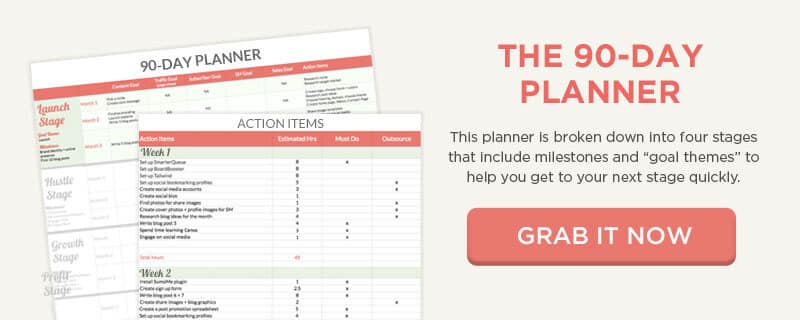7 Easy Ways Avoid Shiny Object Syndrome and Stay on Track
 Good ol’ shiny object syndrome…
Good ol’ shiny object syndrome…
That thing that keeps us hunting for the perfect idea that’s going to change the world and help us make the impact we KNOW we were born to make…
(Hit me with a “right on” if you know what I’m talking about)
Problem is, all those perfect ideas can trick us into thinking:
This one’s gonna be easy.
It usually happens when we’re feeling stuck, overwhelmed, or just plain tired. That’s when you want to turn around and head back to the daydream.
It’s easy to binge-dream on ideas, too. We can come up 25 new ones right in our head…anytime, anywhere. Just like Netflix.
Still, ideas are why we’re entrepreneurs in the first place.
We’re over here solving problems and creating new opportunities!
The question is:
How can we distinguish good ideas from downright bad ones and great ideas from “meh.” Most importantly, how do we know which ideas merit attention right now so we can steer clear of bright shiny objects?
That’s what I want to figure out in this post.
Wish me luck, I’m goin’ in…
First, here’s why we get distracted.
1) Things get murky in the middle
The beginning and the end of anything is easy. It’s the long stretch in the middle that gets fuzzy.
When you can’t see the finish line and things don’t come together as planned, your goals start to fade away.
See:
We’re human beings. We want things to be easy. We’re always going to be drawn to the path of least resistance. It doesn’t matter what the other idea is, we’ll glam it up and make it seem sexy.
(Thoughts on this?)
2) We have competing goals
You know that feeling…
Like, the train left the station and you’ll never catch up?
WITH EVERYTHING?
It can make you feel depressed and overwhelmed, and you won’t even know why.
I think I figured it out:
When you have too many goals competing for your attention, you can’t focus.
There’s something calming about putting your blinders on, keeping your head down, and giving yourself the freedom to pay 100% attention to what’s in front of you. You can only do that when you focus on one goal one at a time.
That’s why it’s super important to identify specific milestones, commit to them, and follow through.
3) We look for distractions
I’m just gonna say it: Sometimes we like shiny object syndrome.
You sit down to create a webinar outline and don’t know what to write…
So you catch up on the news real quick…
Then you log in to Instagram…
Then you check your junk email…
Sometimes finding your focus to work is harder than actually doing it, and you can almost feel your brain shutting down.
Deciding if you want milk in your coffee is like, What’s milk?
When that happens, take a break or go for a walk.
Try to be aware of trivial distractions that steer you off course. If you start Googling stuff you KNOW you don’t care about, shut it down! You’ll be amazed at much you can achieve when you cut out daily actions that don’t align with your end goals.
Here’s how to avoid shiny object syndrome.
Shiny object syndrome is the tendency to chase new ideas, and it affects entrepreneurs because we’re highly motivated and love to try new things.
Those qualities can backfire on us, though. Here’s how to beat it:
1) Create an idea library
It’s a buzz-kill to slay every idea that pops in your head. You need that spark that comes from big-picture dreaming and brainstorming to keep your momentum going. At the same time, it’s important to manage your ideas.
Here’s what I do:
I sprint into action for a month or two. Then I stop to review what I’ve accomplished and plan my next steps. There’s no action happening during the review period, and it usually lasts for two days.
I also use this period to reconnect with my mission and why I’m an entrepreneur, and to mull over any new ideas and opportunities on my plate.
Then on day #3, I edit the ideas (the bad ones get tossed and the good ones go into an idea library).
An idea library is simply a place to stick all your great ideas so you can refer back to them when they better align with your vision. It can be a Google Doc, Evernote file, or a physical notebook that you carry around with you. Whatever works best for you.
You can add to your idea library when you feel inspired. And you’ll have confidence in knowing that your ideas are right there at your fingertips, ready and waiting for you.
2) Pick three goal themes to focus on
Ever notice how successful people are crystal clear on their essential priorities? And how incredibly masterful they are at ignoring everything else?
They stay intensely focused and don’t let anyone, or anything, steer them off course.
That’s what we need to do.
One of the best ways to develop habits that support your creativity is to pick three big “goal themes” and say No to anything else that comes up.
Don’t be afraid to let go here!
When you give 100% of your resources, time and energy to your biggest goals, you will achieve them. Just make sure you start with the right goals.
See:
There’s this sneaky disease called “the planning fallacy” (it’s contagious, and we all have it!). We tend to be overly optimistic and trick ourselves into thinking that we achieve a lot more than we can in a day, a week, a year.
According to Wikipedia:
The planning fallacy is a phenomenon in which predictions about how much time will be needed to complete a future task display an optimism bias and underestimate the time needed.
Think long and hard about your goal themes and what it will take to achieve them before you commit:
- Do you have enough time?
- Do you have the right resources?
- Will you need to build a team to help?
- Does the time frame seem accurate, or too ambitious?
- Most importantly, is this really what you need to focus on right now?
When it comes right down to it, there are four primary phases of building an online business, and each phase has specific milestones. I drill down on the four phases in this post.
Once you’ve decided, it’s Go time. Slap posts-it notes everywhere, baby! On your laptop, computer, refrigerator, iPad, phone, and any place else where you can see them, front and center.
Trust me, you’ll stay focused!
3) Stick to a three-month plan
Remember that sprint I mentioned in step #1, above? It only lasts for three months.
The reason is that when it comes to planning, a year can be deceptively long (and short). The planning fallacy thing kicks in, and you think, In a whole year? I can bang out five courses, create a YouTube channel, host a podcast, be killin’ it with webinars and Facebook ads, have tons of traffic rolling in, and make six figures.
Ha! If only…
More likely, you’ll lack a plan to reach your goals.
The other reason I like to keep the time frame short is, your business will likely shift as you learn more about it, and you’ll need to set new goals accordingly.
With three months, you can get very specific, right down to the daily and weekly activities you need to be doing.
Bonus: If you want, you can use the 90-Day Planner I created for you. Use this to identify your goal themes for the next three months and create a weekly plan. Click on the image below to access.

4) Block schedule your time
If you’re serious about developing habits that support your big vision, you can’t “find” the time to reach your goals. You have to MAKE the time. Structure your days and weeks around key activities and tasks.
(you know I’m about to drill down on time blocking!)
Time blocking is a method of planning your week by turning your to-do list into a visual calendar. Every day has specific times blocked off for specific tasks – right down to the hour and minute.
It’s the fastest approach to achieving your big goals, in my book.
Most of us have amazing ideas we’d like to pursue, but months and years go by without actually bringing that idea to life. This is a way to make them happen! You start seeing what you can really get done in a week (spoiler: it’s less than you think).
Back in the day, I was trapped in this loop of revolving goals.
Every month I wanted to:
- Host a webinar
- Create a course
- Win my first $30K client
No matter how hard I tried, I couldn’t achieve them. Then I started time blocking and everything changed!
I was able to see my progress as I worked toward my goals each week. I knew where to place my focus so I didn’t get distracted. And I knew exactly what I was going to work on every single day.
Want to grab my Time Blocking Template? Just click the image below.

Super simple. Super effective.✌️
5) Switch to just-in-time learning
Who doesn’t love reading posts from your favorite bloggers, or signing up for exciting new courses and trainings?
The truth is, most of us spend more time than we should learning about the latest tips we find on Instagram. And it can lead to overwhelm and shiny object syndrome, fast.
We get caught in a trap of just-in-case learning, hoping THIS tactic or THAT strategy might work for our business. So we buy ebooks and courses that sound amazing. But we never get past the first lesson.
It happens when you lack a clear strategy and purpose for your business. And when your daily activities are based on tips you find instead of a bigger vision.
If you really want to increase your productivity, there are two things you can do:
First, limit just-in-case learning to 5% of your time.
There are gems to be discovered out there, for sure! Just don’t go down a rabbit hole with Google. Instead, set aside 5% of your time to poke around and check out the latest and greatest strategies and techniques..
Save just-in-case learning for your least productive time blocks. For me, that’s right before I go to sleep (I’m out in 15 min, haha).
Next, focus on just-in-time learning.
Just-in-time learning is the opposite of just-in-case learning. You only learn what you need to know right now to achieve a specific goal in your business.
For example:
I spent the better part of six months learning sales funnels because that was my focus. I spoke to everyone I knew, consulted with experts, and researched the heck out of simple, complex, two-step, sideways…every kind of funnel you can imagine. Then I kept my head down and created funnels for my products.
What I didn’t do is…write blog posts, run Facebook ads, create a new course, or even post to my Facebook group.
Listen:
There are only 24 hours in a day. We have to set priorities for what we consume each day, the same way we prioritize our goals.
Just-in-time learning works best when you have clear milestones in place. Use my DIY Your Biz Blueprint if you need help here!
6) You can do anything for a day
Raise your hand if you think about all the things you’re not doing while you’re working. I know I do! ?
It can mess with your head faster than you can say FOMO. As if…some time machine is going to whisk us away from everything and we’ll something really BIG. It’s crazy!
Here’s what helps me get past it:
I remind myself that it’s not a month, a year, or the rest of my life. Just like when I hit mile 7 on my runs (and I really, really want to quit), and I think…
You can do anything for five more minutes.
You can do anything for a day.
No matter what you’re working on, Instagram and Facebook and emails and texts and Google will all be there tomorrow, *sigh. ?
7) Review your progress daily
Projects that take too looong can throw you off track faster than anything else.
Sundays you get we’re super pumped thinking about everything you’re going to get done. Then it’s Monday at 2:00pm and you haven’t touched ANYTHING on your list. By Tuesday, you’re already flustered and wondering what the heck you should be working on.
So what’s the solve?
Bake *forgiveness* into your schedule. Keep it lean and flexible.
Here’s how:
Spend 15 minutes at the end of each day to review what you accomplished and reschedule things you didn’t get to. Then update Tuesday’s schedule based on Monday’s progress so that you feel refreshed and focused instead of all over the place.
Rinse and repeat for the rest of the week.
Real quick, before I forget…
You’ll start to notice that certain tasks take a back seat every week.
Those are ones that probably still need to get done, just not by you. Try to find someone who can help.
And whatever you do, don’t stress when your week comes undone and everything gets rescheduled (oh yeah, been there!).
Productivity is one big game of shuffle board, if you ask me!
It’s NOT about getting everything done…
It’s about prioritizing your time, getting clear on what YOU need to do to move your business forward, and learning to delegate other tasks.






Prioritizing is so important and something I feel like I am consistantly trying to do. Everything seems to ebb and flow!
Ohhh I know this syndrome all too well! Thanks for your helpful tips :).